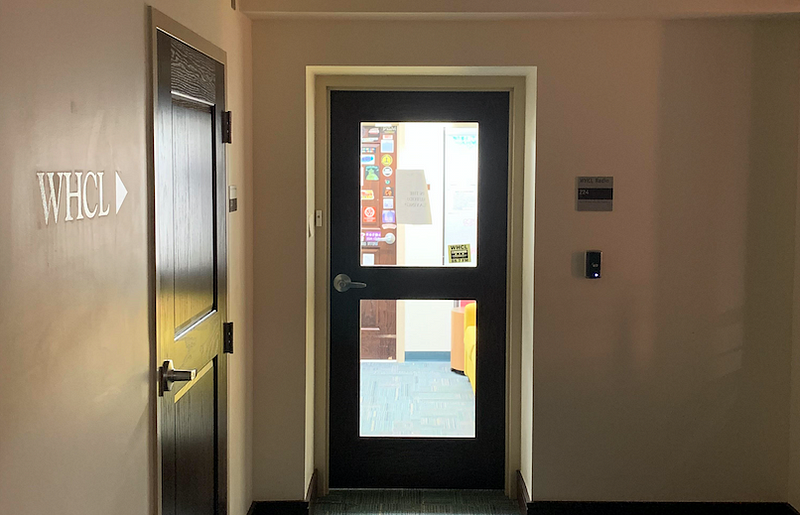
For many students, the WHCL studio is a room in which they feel comfortable to express themselves and their interests freely. Photo courtesy of Matthew Collins.
Despite my longstanding hope to one day have my own radio show, I had never entered the radio booth on the second floor of Sadove before this week. It should not come as a surprise to anyone, then, that when offered the chance recently to sit in on a show at WHCL, Hamilton’s resident radio station, I jumped at the opportunity.
The booth, cramped though it was, appeared to me a palace, all lights and sliders and CDs, some brand-new and some long-forgotten. The nighttime session passed in a delirious blur, as the massive microphones and the thrill of heading out on the air left me giddy with excitement. For those precious moments, I was a child again.
The experience was magical, but there is much more to college radio than the many memorable nights like mine they help create. Make no mistake: WHCL, much like its sister stations across the nation, is a special resource that we should never take for granted.
Campus radio has been around for an impressively long time; the longest active stations in the United States have been in operation for roughly a century. Their roles have been all-purpose for nearly as long; commercial radio broadcasts largely began as news-oriented ventures, but quickly branched out into a variety of topics (e.g. music and commentary). WHCL itself has been around since the Second World War, and its hodgepodge of student-driven content has consistently graced the Mohawk Valley for much of the interval following its founding.
However, despite this rich history, WHCL’s current presence in campus culture seems peripheral at best. The station has always had competition for students’ time from Hamilton’s rigorous academic expectations and considerable variety of clubs; however, the ubiquity of newer, more flexible forms of media — most notably the proliferation of podcasts and music streaming — have recently muscled the venerable art form of radio out of our collective consciousness. This, to put it briefly, is a travesty.
The malleability of radio programming, for one, places it in a unique place among college traditions. The historical nature of many stations ensures a connection between the present and past for many students behind the booth, without any of the baggage that academic traditions can contain in the harsh light of the present day. This same quality ensures these stations always remain relevant to a degree within the broader cultural backdrop of each student body; radio legacies are uninheritable, and the topics of one year’s radio show are always liable to change in accordance with the interests of incoming students.
Radio programming is not, however, completely in thrall to the lowest common denominator; individual interests can shine through on one’s program without being overwhelmed by the broader tendencies of the masses. For some students, the chance to express themselves on WHCL — free from the constricting immediacy of social dynamics — is greatly appreciated. “My experience [in radio] has been very liberating and stress-relieving,” stated Helair Charles ’24, a sentiment surely shared by many Hamilton students when given the reins in an environment that facilitates creativity and self-assertion.
Radio programming is also highly accessible, with a low requirement in terms of both time and technical proficiency. Students at Hamilton are free to apply for the extensive number of time slots available at the start of each semester without much fuss, and the learning curve in such positions is generally flat. Such approachability is ripe for collaboration, enabling Hamiltonians to develop and share their common interests with the rest of the student body. “My friend Gabriel [Bit-Babik ’25] had a radio show as a freshman, but it was a solo operation,” recounted Stephen Socolow ’25. “He considered stopping next year, but I suggested that I join him instead.” Bit-Babik’s and Socolow’s show explores the niche topic of (primarily vintage) synthesizers, and the duo have already developed a compelling dynamic that grips the listener in spite of the relatively obscure subject at hand. While collaborations such as these often display natural chemistry between co-hosts, without the guiding hand of college radio, it is doubtful that such dynamics would come to fruition. This is not to suggest that collaboration is necessary to succeed, of course; the outlet of the radio show additionally offers an unimpeded voice for Hamilton’s voiceless. “On this campus, I don’t really get to be heard most of the time,” revealed Charles. “I get to say what I want to say [on WHCL]. Getting this job takes advantage of being invisible to some people.”
All of these signs indicate encouragingly that while radio’s halcyon days may be done, Hamilton students are growing to cherish their radio station. There are already positive signs emerging that WHCL is earning its long-due appreciation from students on the Hill; this year reportedly saw record numbers of applicants for the limited number of slots at all hours of the day.
“WHCL gives me a chance to express myself in a way that would not ordinarily be available to me,” declared radio host Oliver Tennant ’23. “It allows me to develop my public speaking skills as well.” While newer technology may have flashiness and convenience on its side, college radio is still growing strong.